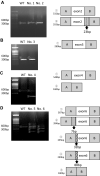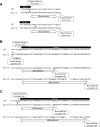Functional analysis of suspected splicing variants in CLCN5 gene in Dent disease 1
- PMID: 32201916
- PMCID: PMC7935734
- DOI: 10.1007/s10157-020-01876-x
Functional analysis of suspected splicing variants in CLCN5 gene in Dent disease 1
Erratum in
-
Correction to: Functional analysis of suspected splicing variants in CLCN5 gene in Dent disease 1.Clin Exp Nephrol. 2021 May;25(5):564. doi: 10.1007/s10157-021-02041-8. Clin Exp Nephrol. 2021. PMID: 33721133 Free PMC article. No abstract available.
Abstract
Background: In recent years, the elucidation of splicing abnormalities as a cause of hereditary diseases has progressed. However, there are no comprehensive reports of suspected splicing variants in the CLCN5 gene in Dent disease cases. We reproduced gene mutations by mutagenesis, inserted the mutated genes into minigene vectors, and investigated the pathogenicity and onset mechanisms of these variants.
Methods: We conducted functional splicing assays using a hybrid minigene for six suspected splicing variants (c.105G>A, c.105+5G>C, c.106-17T>G, c.393+4A>G, c.517-8A>G, c.517-3C>A) in CLCN5. We extracted information on these variants from the Human Gene Mutation Database. We reproduced minigene vectors with the insertion of relevant exons with suspected splicing variants. We then transfected these minigene vectors into cultured cells and extracted and analyzed the mRNA. In addition, we conducted in silico analysis to confirm our minigene assay results.
Results: We successfully determined that five of these six variants are pathogenic via the production of splicing abnormalities. One showed only normal transcript production and was thus suspected of not being pathogenic (c.106-17T>G).
Conclusion: We found that five CLCN5 variants disrupted the original splice site, resulting in aberrant splicing. It is sometimes difficult to obtain mRNA from patient samples because of the fragility of mRNA or its low expression level in peripheral leukocytes. Our in vitro system can be used as an alternative to in vivo assays to determine the pathogenicity of suspected splicing variants.
Keywords: CLCN5; In silico; Minigene; Splicing; Variant.
Conflict of interest statement
The authors declare that there is no conflict of interest.
Figures



Similar articles
-
The Contribution of COL4A5 Splicing Variants to the Pathogenesis of X-Linked Alport Syndrome.Front Med (Lausanne). 2022 Feb 8;9:841391. doi: 10.3389/fmed.2022.841391. eCollection 2022. Front Med (Lausanne). 2022. PMID: 35211492 Free PMC article. Review.
-
The first Sri Lankan family with Dent disease-1 due to a pathogenic variant in the CLCN5 gene: a case report.BMC Res Notes. 2017 Oct 30;10(1):539. doi: 10.1186/s13104-017-2881-5. BMC Res Notes. 2017. PMID: 29084614 Free PMC article.
-
Identification of a novel mutation in the CLCN5 gene in a Chinese family with Dent-1 disease.Nephrology (Carlton). 2014 Feb;19(2):80-3. doi: 10.1111/nep.12179. Nephrology (Carlton). 2014. PMID: 24428215
-
Pathogenic evaluation of synonymous COL4A5 variants in X-linked Alport syndrome using a minigene assay.Mol Genet Genomic Med. 2020 Aug;8(8):e1342. doi: 10.1002/mgg3.1342. Epub 2020 Jun 16. Mol Genet Genomic Med. 2020. PMID: 32543079 Free PMC article.
-
[From gene to disease; Dent's disease caused by abnormalities in the CLCN5 and OCRL1 genes].Ned Tijdschr Geneeskd. 2007 Oct 27;151(43):2377-80. Ned Tijdschr Geneeskd. 2007. PMID: 18019214 Review. Dutch.
Cited by
-
The Contribution of COL4A5 Splicing Variants to the Pathogenesis of X-Linked Alport Syndrome.Front Med (Lausanne). 2022 Feb 8;9:841391. doi: 10.3389/fmed.2022.841391. eCollection 2022. Front Med (Lausanne). 2022. PMID: 35211492 Free PMC article. Review.
-
All reported non-canonical splice site variants in GLA cause aberrant splicing.Clin Exp Nephrol. 2023 Sep;27(9):737-746. doi: 10.1007/s10157-023-02361-x. Epub 2023 May 31. Clin Exp Nephrol. 2023. PMID: 37254000 Free PMC article.
-
Pediatric Dent disease presenting with rickets and end-stage renal disease: case report and literature review.J Int Med Res. 2024 Sep;52(9):3000605241280048. doi: 10.1177/03000605241280048. J Int Med Res. 2024. PMID: 39327974 Free PMC article. Review.
-
The Site and Type of CLCN5 Genetic Variation Impact the Resulting Dent Disease-1 Phenotype.Kidney Int Rep. 2023 Mar 23;8(6):1220-1230. doi: 10.1016/j.ekir.2023.03.012. eCollection 2023 Jun. Kidney Int Rep. 2023. PMID: 37284679 Free PMC article.
-
Potential involvement of abnormal splicing in severe WT1-related disorders.Clin Exp Nephrol. 2025 Jun 10. doi: 10.1007/s10157-025-02715-7. Online ahead of print. Clin Exp Nephrol. 2025. PMID: 40493154
References
-
- Forino M, Graziotto R, Tosetto E, Gambaro G, D'Angelo A, Anglani F. Identification of a novel splice site mutation of CLCN5 gene and characterization of a new alternative 5' UTR end of ClC-5 mRNA in human renal tissue and leukocytes. J Hum Genet. 2004;49(1):53–60. doi: 10.1007/s10038-003-0108-1. - DOI - PubMed
MeSH terms
Substances
Supplementary concepts
Grants and funding
LinkOut - more resources
Full Text Sources
Medical

